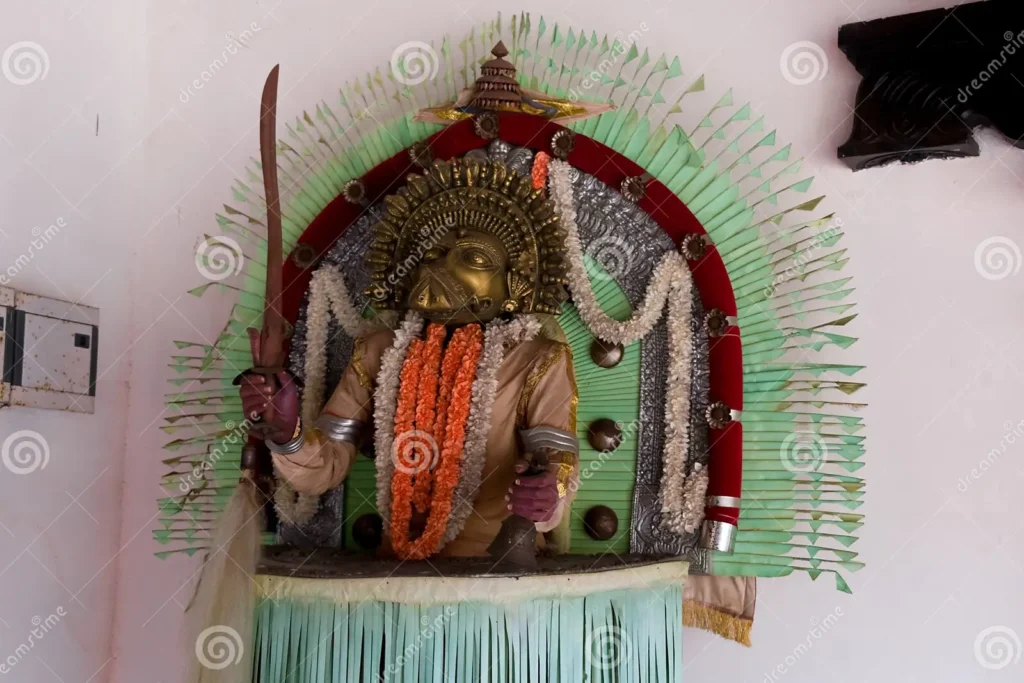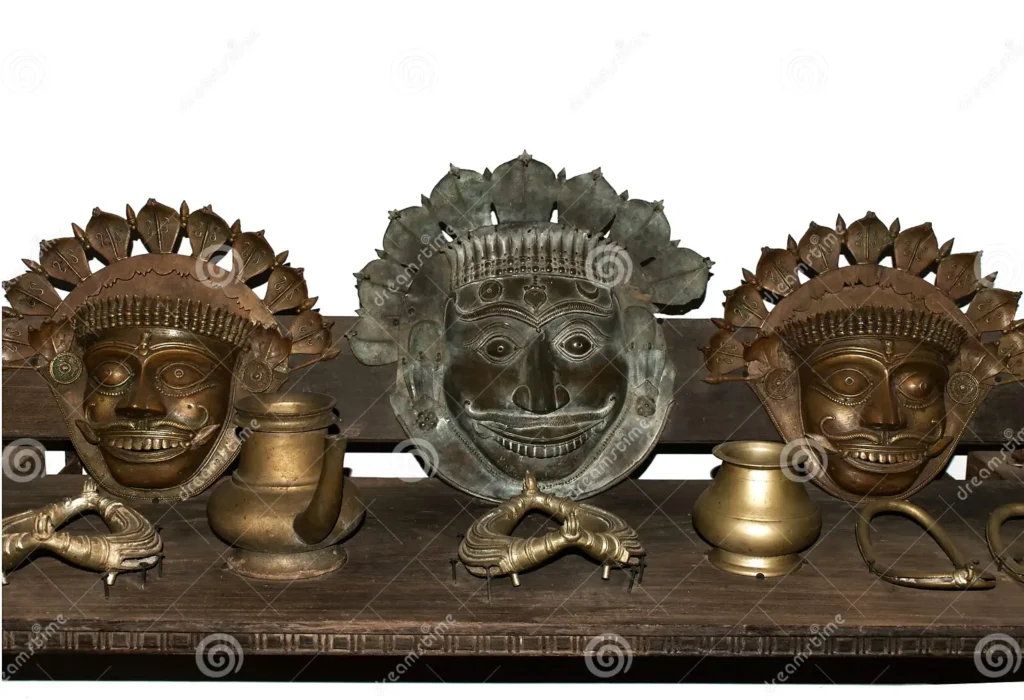
Deities are expressions of the source of creation in a divine energy form. People connect to deities for different purposes, the main one being liberation. There are various methods to connect with a deity, it could be through your karma (actions), meditative practices or rituals. Panjulri Daiva is a manifestation of Lord Vishnu, who is mainly worshipped in parts of South India ( prominently in Karnataka).
Devotees of Panjurli still conduct Bhuta Kola, a ritual to seek the blessings of Lord Panjurli every year till the present date. Panjurli is, in particular, deeply connected / associated with Varaha, an avatar of Vishnu. In Hinduism, gods and deities are said to manifest locally according to the social situations, combined with the needs and the times of the different geographical locations, and Panjurli Deva, along with Guliga, are a beautiful example of this phenomenon.
The Story of Panjurli

Panjurli Daiva is a Vishnu Gana. There are 3 main gods who are said to have the power of creation (Brahma), maintainence (Vishnu), and destruction (Shiva) of the universe. Ganas of a particular god are said to be a more condensed expression of the same energy, which the people of specific locations or karmic energies can connect with more easily. Fundamentally, there is no difference between Vishnu and Panjurli, but it is the need of the times that calls for Vishnu to manifest himself as Panjurli.
Panjurli Daiva is said to have arrived on earth at the start of mankind’s evolution. In the times or the early settlers who had just invented the process of farming, it is believed that people witnessed a mysterious boar / boars that used to eat the crops of the farmers for satisfying their hunger. It is around this time that people believed the boars to be a manifestation of the divine, and started worshipping them as Lord Panjurli for the protection of their crops.
It is believed that after the above course of events, the stories of Lord Panjurli were written in Hindu religious books and worshipping the deity became a part of the culture. The story starts with mentioning that Devi Parvati used to have a pet boar, which was very dear to her. The boar was mischevious in his initial days, and used to destroy the gardens present on Mount Kailash on a regular basis.
This act of the boar angered Lord Shiva and he severed the boar’s head. After his death, Devi Parvati was heartbroken and on her insistence, Shiva revived the boar in the form of a divine energy and sent him to Earth for the protecting the people and guiding them from the dark towards the light.
The Significance of Bhuta Kola

The word “Bhuta” literally translates to “past”, but in the context of the Kola, it refers to the practice being periodic. It is done by specific clans, whose ancestors had consecrated different deities for their own particular genetics. Not only Panjurli Daiva, but many other deities are also worshipped across India by different sects of people.
The Bhuta Kola is a ritualistic procedure that is done in order to interact with the deity. One particular person during the Kola is said to be “possessed” by the deity for a short span of time during which the people of the land can interact with their deity. There are about 22 steps to the procedure, in which the 6 of them have to be completed before the Kola. The person who is going to be possessed often has to go through face painting, and perform a ritualistic dance.
A more detailed account of the steps of the Bhuta Kola can be found in podcasts. Bhuta Kola cannot be performed by any person, but only by those people, who have the necessary ancestry to do so. It is performed regularly in South India.
how to Witness Panjurli
Trying to perform a Bhuta Kola on your own in order to interact with any deity is not advisable at all. If one really wishes to interact with a deity, they can make plans to go to South India. There is no restriction on outsiders witnessing Bhuta Kolas, and there have been many records of people visiting different regions to witness Bhuta Kolas.
Bhuta Kolas are usually conducted in Tulu Nadu. There are different villages or non-urban areas where the practice of Bhuta Kolas is still prevalent. One can go to this region and witness a Kola by talking to the people over there. A Bhuta Kola can only be witnessed by an individual if the deity deems him/her to be worthy.
A lot of people have recorded fainting on witnessing a Kola for the first time. The energy of the deity is said to be really intense and can be really shocking for someone who is witnessing a Bhuta Kola for the first time.
The Importance of Guliga
Guliga Daiva, is often associated with Panjurli Daiva. Worshippers of Panjurli, usually have Guliga Daiva as their Kshetrapala and worship him for protection. The role of any deity who is a Kshetrapala is to protect his devotees, and to destroy their enemies in case someone tries to harm them.
As Panjurli is said to be a manifestation of Lord Vishnu, Guliga is said to be a manifestation of Lord Shiva. He is of a fierce nature, when compared with Panjurli Daiva who is more gentle and compassionate. This difference in their mannerisms can be attributed to the different roles that they serve for their devotees.
Conclusion
To conclude, Lord Panjurli is a localized manifestation of Lord Vishnu present in the Tulu Nadu region of India. He is a compassionate and kind entity, who interacts with his devotees and guides them for their spiritual progress. The annual act of Bhuta Kola by various different sects is an attempt to please the deity, and the deity always responds to his true devotee’s prayers.
Lord Panjurli often manifests along with Guliga, who is the Kshetrapala of that particular region. Both of these energies in synergy, always work for the betterment of their devotees and help in protecting them from their enemies.
FAQs (Frequently Asked questions)
1. Who is Panjurli?
Panjurli Daiva is a localized manifestation of Lord Vishnu, and is worshipped across the Tulu Nadu region. He is of a gentle and compassionate nature, and guides his devotees from the darkness to the light. He regularly interacts with his devotees during the Bhuta Kola and is often associated with wearing Kantara.
2. Why does Panjurli scream?
Panjurli screams in order to let his emotions be known to the people. There are different expressions with which he screams, if one listens carefully. Panjurli’s devotees perceive his screams as a declaration or a verdict. Apart from this, the energy of the deity might be too much to handle for the human who is being possessed, and the energy might be looking for an outlet and getting it in the form of screams.
3. Who is Guliga?
Guliga is a Kshetrapala deity. He has a fierce form and he appears whenever an unjust harm comes to his land’s devotees. He is a manifestation of Lord Shiva (Shiva Gana), and often works together with Lord Panjurli for the betterment of the people.
